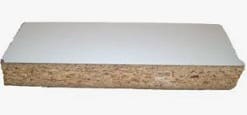 The notion of melamine comes from the French word mélamine . The concept refers to a crystalline substance that is used to produce synthetic resins .
The notion of melamine comes from the French word mélamine . The concept refers to a crystalline substance that is used to produce synthetic resins .
It is an organic compound that develops naturally as a white solid element. Its formula is C3H6N6 and it can dissolve in water .
The condensation of formaldehyde and phenylamine allows the formation of melamine resins . These materials are often used for the production of furniture and as adhesives in the generation of chipboard.
Phenylamine is also known by the names aniline or aminobenzene . It is a liquid organic compound whose color is usually yellow and its smell is very particular. At room temperature it is not common to evaporate and it is poorly soluble in water, although it dissolves easily using almost any organic solvent.
Regarding formaldehyde, another name it receives is methanal . It is a chemical compound, the simplest of the aldehydes, whose volatility and flammability are considerable. To obtain it, it is necessary to subject the methyl alcohol to catalytic oxidation. It is a colorless gas if it is at normal temperature and pressure. Its odor is intense and it is soluble in esters and water.
Although there are solid resins and others in powder form, the general characteristics of all of them are the following:
* its color is brown or reddish;
* The form in which melamine resins are materialized is crystals;
* its softening point is high;
* its fluency is poor;
* they are not soluble in common solvents;
* resist bases, also called alkalis , a series of substances with alkaline properties;
* have a low loss factor at high frequency;
* Its insulation resistance is brilliant;
* is not recyclable.
One of the most common uses for melamine resins is in molding compounds . In car paint , one of the most important stages of its manufacturing, base resins are used, which are divided into two groups: methylated ones (which react with methanol) and butylated or isobutylated ones (which react with butanol or isobutanol, respectively). These are crystalline resins, with a solids content that exceeds 95 percent and are colorless.
A melamine board , in this context, is a board developed with melamine resins. Its coating gives it great resistance to humidity and the action of various chemicals. It also resists scratches.
These boards can be glued and assembled in multiple ways. Thanks to the use of bolts, screws, nails and/or adhesives, melamine plates can be joined together in a durable way and thus give rise to countless pieces of furniture and spatial divisions of environments .
 In addition to standing out for their resistance and structural stability, melamine planks function as acoustic and thermal insulators. That is why the use of this compound is very frequent.
In addition to standing out for their resistance and structural stability, melamine planks function as acoustic and thermal insulators. That is why the use of this compound is very frequent.
It is important to emphasize that one advantage that melamine furniture offers is its low cost compared to other similar products. Melamine furniture, for example, is usually cheaper than wooden furniture.
Ease of cleaning is another benefit that melamine provides. While acids and solvents tend to damage wood, melamine is more resistant, although it is best to opt for items created specifically for this material.
Given the high nitrogen content of melamine, for several years it was used to adulterate different food products, both for humans and animals, to appear to have a higher protein content than the real one. The most direct consequence of this practice is that they make the food toxic.
